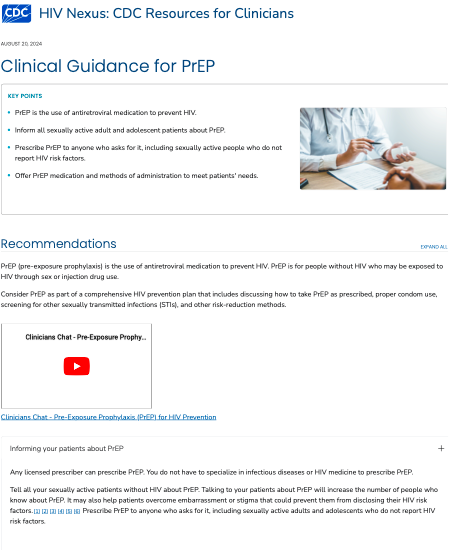 Image 1 of
Image 1 of


HIV Nexus: Clinical Guidance for PrEP
The HIV Nexus: Clinical Guidance for PrEP is a deleted CDC publication, preserved here in its unchanged original form. This document provides evidence-based clinical guidelines for healthcare providers on prescribing Pre-Exposure Prophylaxis (PrEP) for HIV prevention. It is part of the CDC’s HIV Nexus initiative, which supports clinicians in preventing, diagnosing, and managing HIV.
Key Features of the Guidance:
PrEP Overview: PrEP is an antiretroviral medication regimen used to prevent HIV in individuals at risk through sexual exposure or injection drug use.
Universal Patient Education: Healthcare providers are encouraged to inform all sexually active adult and adolescent patients about PrEP, regardless of disclosed risk factors.
Prescribing Best Practices:
PrEP should be offered to any patient who requests it, including those who do not report HIV risk factors.
Three FDA-approved PrEP options are available:
Daily Oral PrEP with F/TDF (Truvada® or generic equivalent)
Daily Oral PrEP with F/TAF (Descovy®)
Injectable PrEP with CAB (Apretude®) every two months
Baseline HIV Testing is required before initiating PrEP to confirm the patient does not have HIV.
Monitoring & Follow-Up:
Quarterly HIV testing and routine STI screening for sexually active individuals on PrEP.
Kidney function monitoring for patients using oral PrEP.
Counseling on adherence and risk reduction strategies.
Considerations for Special Populations:
Transgender and nonbinary individuals: No known drug interactions between PrEP and hormone therapy.
Pregnancy & Breastfeeding: Oral PrEP (F/TDF) is considered safe, while data on injectable PrEP (CAB) in pregnancy are still limited.
Adolescents: PrEP is approved for individuals weighing at least 77 lbs (35 kg), but adherence support is crucial.
People Who Inject Drugs: PrEP is highly effective in reducing HIV transmission through injection drug use; patients should also have access to sterile injection equipment.
Disclosure:
This document is presented in its unaltered form as originally published by the CDC before its removal.
The HIV Nexus: Clinical Guidance for PrEP is a deleted CDC publication, preserved here in its unchanged original form. This document provides evidence-based clinical guidelines for healthcare providers on prescribing Pre-Exposure Prophylaxis (PrEP) for HIV prevention. It is part of the CDC’s HIV Nexus initiative, which supports clinicians in preventing, diagnosing, and managing HIV.
Key Features of the Guidance:
PrEP Overview: PrEP is an antiretroviral medication regimen used to prevent HIV in individuals at risk through sexual exposure or injection drug use.
Universal Patient Education: Healthcare providers are encouraged to inform all sexually active adult and adolescent patients about PrEP, regardless of disclosed risk factors.
Prescribing Best Practices:
PrEP should be offered to any patient who requests it, including those who do not report HIV risk factors.
Three FDA-approved PrEP options are available:
Daily Oral PrEP with F/TDF (Truvada® or generic equivalent)
Daily Oral PrEP with F/TAF (Descovy®)
Injectable PrEP with CAB (Apretude®) every two months
Baseline HIV Testing is required before initiating PrEP to confirm the patient does not have HIV.
Monitoring & Follow-Up:
Quarterly HIV testing and routine STI screening for sexually active individuals on PrEP.
Kidney function monitoring for patients using oral PrEP.
Counseling on adherence and risk reduction strategies.
Considerations for Special Populations:
Transgender and nonbinary individuals: No known drug interactions between PrEP and hormone therapy.
Pregnancy & Breastfeeding: Oral PrEP (F/TDF) is considered safe, while data on injectable PrEP (CAB) in pregnancy are still limited.
Adolescents: PrEP is approved for individuals weighing at least 77 lbs (35 kg), but adherence support is crucial.
People Who Inject Drugs: PrEP is highly effective in reducing HIV transmission through injection drug use; patients should also have access to sterile injection equipment.
Disclosure:
This document is presented in its unaltered form as originally published by the CDC before its removal.
The HIV Nexus: Clinical Guidance for PrEP is a deleted CDC publication, preserved here in its unchanged original form. This document provides evidence-based clinical guidelines for healthcare providers on prescribing Pre-Exposure Prophylaxis (PrEP) for HIV prevention. It is part of the CDC’s HIV Nexus initiative, which supports clinicians in preventing, diagnosing, and managing HIV.
Key Features of the Guidance:
PrEP Overview: PrEP is an antiretroviral medication regimen used to prevent HIV in individuals at risk through sexual exposure or injection drug use.
Universal Patient Education: Healthcare providers are encouraged to inform all sexually active adult and adolescent patients about PrEP, regardless of disclosed risk factors.
Prescribing Best Practices:
PrEP should be offered to any patient who requests it, including those who do not report HIV risk factors.
Three FDA-approved PrEP options are available:
Daily Oral PrEP with F/TDF (Truvada® or generic equivalent)
Daily Oral PrEP with F/TAF (Descovy®)
Injectable PrEP with CAB (Apretude®) every two months
Baseline HIV Testing is required before initiating PrEP to confirm the patient does not have HIV.
Monitoring & Follow-Up:
Quarterly HIV testing and routine STI screening for sexually active individuals on PrEP.
Kidney function monitoring for patients using oral PrEP.
Counseling on adherence and risk reduction strategies.
Considerations for Special Populations:
Transgender and nonbinary individuals: No known drug interactions between PrEP and hormone therapy.
Pregnancy & Breastfeeding: Oral PrEP (F/TDF) is considered safe, while data on injectable PrEP (CAB) in pregnancy are still limited.
Adolescents: PrEP is approved for individuals weighing at least 77 lbs (35 kg), but adherence support is crucial.
People Who Inject Drugs: PrEP is highly effective in reducing HIV transmission through injection drug use; patients should also have access to sterile injection equipment.
Disclosure:
This document is presented in its unaltered form as originally published by the CDC before its removal.
